Obama in Asia – Part III
Obama in Asia – Part III
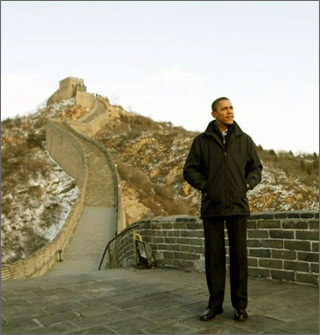
SHANGHAI: With President Obama’s visit to China just finished, there’s much to contemplate with regard to the dynamics between the two nations that many, rightly or wrongly, are calling a G2. Obama came to China attempting to settle the direction of America’s relationship with the People’s Republic, and left with increasing China’s international standing by mostly accepting the Chinese terms of the relationship. Seen from an historical context, for the first time China is much more equal to America, partly through its rise and partly due to America’s stagnancy.
Obama’s visit reaffirmed the recognition that the two countries share far more common grounds than differences, and they aspire to expand cooperation and handle differences respectfully rather than in a confrontational manner.
This notion was reflected in their Joint Statement issued on November 17 – the unprecedented document of some 6,500 words detailed a wide range of areas where they need to collaborate, from nurturing strategic trust to economic cooperation, from responding to regional and global challenges to dealing with climate change and protecting the environment.
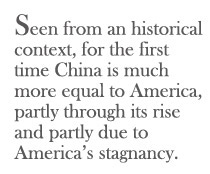
The two countries made encouraging headway on a number of issues. The US vowed not to contain China (Beijing could interpret it as Washington could not afford a containment policy at all), and China welcomed America to make the Asia-Pacific region more peaceful, stable and prosperous. On the most perennially thorny issue of Taiwan, Obama and Hu Jintao agreed to respect national sovereignty and territorial integrity as the fundamental principle – a code for recognition of China’s unchallenged rule of Tibet and Xinjiang.
There is delicate balancing on the Taiwan question. President Obama mentioned the three Communiqués but not the Taiwan Relations Act (the Congressional mandate requiring the US to come to Taiwan’s defense in case of need), when answering a question in his town-hall meeting in Shanghai, but he balanced this at the press conference in Beijing. However, at the Joint Statement, again the TRA didn’t surface, likely due to China’s opposition. As aforementioned, the Statement has affirmed the principle of respecting sovereignty and territorial integrity in handling Taiwan, further restraining Washington’s freedom to intervene in Taiwan.
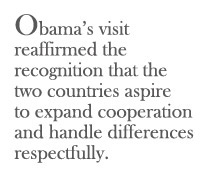
The US and China agreed to lift the military exchange next year to a higher level and with greater frequency, and to resume the dialogue on human rights. They also agreed to exchange intelligence so as to curtail various trans-border crimes. China and the US agreed to assure the success of the Non-Proliferation Treaty (NPT) review conference next year, and will each push for the ratification of the Comprehensive Test Ban Treaty (CTBT). Indeed, if they will ratify the CTBT, Indonesia, India and Pakistan are likely to feel compelled to do so as well.
Noteworthy too is that China and the US mentioned supporting the reconciliation process between India and Pakistan. Though the wording itself was not politically incorrect, the way they addressed world affairs, South Asia in this case, could raise eyebrows in India, as New Delhi could feel sensitive about its neighbor corralling Washington to judge India’s foreign policy, especially in the light of long-standing Chinese-Pakistani partnership. Given the recent tense border dispute with India, some might see this as a diplomatic victory for China by giving it a recognized role in South Asia.
At a strategic level, China and the US agreed to continue to push for North Korea’s nuclear disarmament. Beijing welcomes a pending high-level contact between the US and the DPRK, in the hope that this could help resume the Six Party Talks to dismantle Pyongyang’s nuclear weapons program. But the outcome of successful cooperation could turn out to be slim, as the DPRK is not likely to accept the US’ terms that Obama made in Seoul after his Beijing visit. That is, America is ready to help the DPRK integrate into the international community only so long as Pyongyang dismantles its nuclear weapons program comprehensively, verifiably and irreversibly. As the DPRK is not likely to accept this stringent requirement, the Six Party Talks should be difficult to resume.
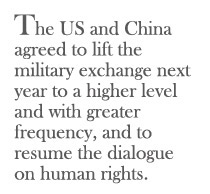
Surprisingly, some vital issues for the US, like currency exchange which loomed large before the summit, were shelved for future negotiation. Obama didn’t seem to be interested in pushing hard for China to appreciate its currency, which is viewed as undervalued. It is understood that China would not make a tangible commitment to appreciating its currency. Instead the two sides decided to take a “forward-looking” currency policy, linking domestic currency to global economy.
On respective rebalancing of economic development, China and the US have made it clear that China would adjust its economic structure and raise family income, increasing the contribution of domestic consumption to its economic output. For the US part, Obama committed to increasing private saving to advance sustainable development. A year after the financial crisis shook the world, both tacitly admit that their economic modality has to be transformed.
Despite the pledge of cooperation in the Joint Statement the two countries remain apprehensive of each other’s defense build-up. The US has doubled its defense spending over the past eight years and China has nearly quadrupled its outlays over the same period, though it still spends one eighth of the US budget. Nevertheless, President Obama’s visit has helped set the stage of the enhanced level and frequency of military to military exchange between the two armed forces, rendering better transparency of respective intention and capacity.
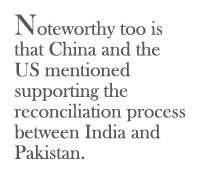
Obama’s “courtesy diplomacy” seemed to win favor among the general public in China, though his town hall meeting was broadcast internationally but not nationwide. However, while his visit demonstrated the ever strengthening bond between them, the US and China still differ in many crucial areas – human rights, Taiwan, Tibet, currency exchange and trade protectionism for instance. Though both are content to improve relations across Taiwan Strait, they still differ, sometimes in a nuanced way, on the US role in the Taiwan question. They also disagree on how to cope with the Dalai Lama – at a press conference, Obama openly suggested a dialogue with the Dalai Lama while Beijing responded that all countries have their own internal situation.
In the end, the general tone of Obama’s visit was positive. When addressing some of their tough differences, both governments expressed desire to deal with each other with respect, and to deepen their strategic ties. When Obama announced that the US will promote a program to send some 100,000 American students to China in the next four years, his administration appeared to pay respect to a rising power, preparing the next generation of US leadership to be knowledgeable in China affairs.
In one month’s time, China will likely emerge as the second biggest economy in the world. A realistic American president has to partner with this rising power with more equality and mutual respect. Not only has his visit helped enthrone China as a more equal power, but his recent concession on the US FAA certification of Chinese commercial jets – so far denied by the US – could allow China to compete with Boeing. The world is truly entering a new stage of co-power structure where both the US and China are collaborating for common goods, as well as competing when their national interests diverge.
Shen Dingli is a professor and Director of the Center for American Studies and Executive Dean of the Institute of International Studies at Fudan University in Shanghai, China.